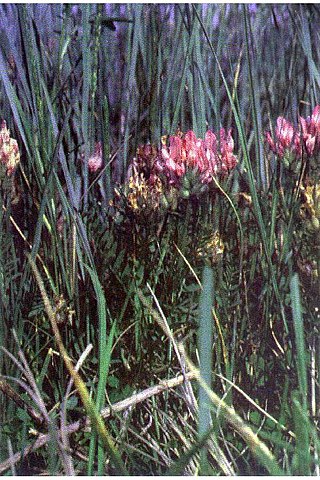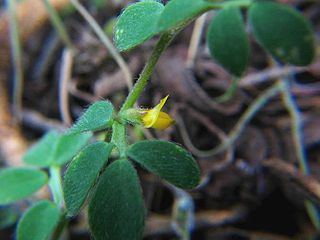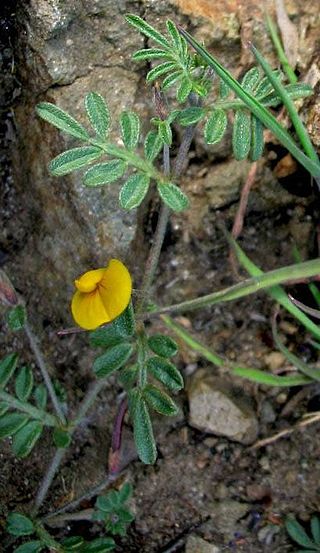
Astragalus agrestis is a species of milkvetch known by the common names purple milkvetch, purple loco, and field milkvetch. It is native to much of western and northern North America from most of Canada to the southwestern United States, as well as eastern Asia. It grows in vernally moist areas such as meadows, and is often found in sagebrush.

Astragalus californicus is a species of milkvetch known by the common name Klamath Basin milkvetch.

Acmispon argophyllus, synonym Lotus argophyllus, is a species of legume native to California and northwest Mexico. It is known by the common name silver bird's-foot trefoil or silver lotus.

Acmispon dendroideus, synonym Syrmatium veatchii, is a species of legume native to California. It is known by the common name island broom. It is endemic to the Channel Islands of California, where it grows on coastal bluffs and cliffs. It is a spreading perennial herb or erect shrub approaching 2 meters in height. It is hairless to hairy and gray-green in color. The branches lined with leaves each made up of a few oval leaflike leaflets up to 1.5 centimeters long each. The inflorescence bears up to 10 yellow pealike flowers, each roughly a centimeter long and fading red as they age.
Acmispon denticulatus is a species of legume known by the common name riverbar bird's-foot trefoil. It is native to western North America from British Columbia to California to Utah, where it grows in moist spots in a number of habitat types. It is an annual herb growing erect or spreading to about 40 cm in maximum length. It is lined with leaves each made up of a few alternately arranged oval leaflets 1 to 2 cm long, sometimes slightly hairy in texture. The inflorescence is made up of one or two whitish to yellowish pealike flowers located in leaf axils. The fruit is a hairy legume pod up to about 1.5 cm long.

Acmispon grandiflorus, synonym Lotus grandiflorus, is a species of legume native to western North America. It is known by the common name chaparral bird's-foot trefoil.
Hosackia incana, synonym Lotus incanus, is a species of legume native to California. It is known by the common name woolly bird's-foot trefoil. It is endemic to the Sierra Nevada of California, where it grows in forests and other mountain habitat.
Acmispon junceus, synonyms Lotus junceus and Syrmatium junceum, is a species of legume native to California. It is known by the common names rush broom and rush deervetch. It is endemic to California, where it is known from the northern and central coast and the coastal mountain ranges. It can be found from beaches inland to serpentine slopes and chaparral. It is a hairy, prostrate or spreading perennial herb lined with leaves each made up of small oval leaflets. The inflorescence bears up 8 yellow pealike flowers each up to about a centimeter long. The fruit is a small beaked legume pod.

Acmispon parviflorus, synonym Lotus micranthus, is a species of legume. It is known by the common name desert deervetch. It is native to western North America from British Columbia to southern California, where it is known from many types of habitat. It is a hairy to hairless annual herb lined with leaves each made up of small oval leaflets. Solitary flowers appear in the leaf axils. Each is an ephemeral pinkish pealike bloom under a centimeter long. The fruit is a narrow, hairless, wavy-edged legume pod up to about 2.5 centimeters long.

Acmispon wrangelianus is a species of legume native to California and Oregon in the southwestern United States. It is known by the common names Chilean bird's-foot trefoil and Chile lotus. Despite its common name, it is not from Chile. It can be found in many types of habitat, including disturbed areas. This is a hairy, prostrate annual herb. Its slender branches are lined with leaves each made of generally four small leaflets. The inflorescence is composed of a solitary yellow pealike flower around a centimeter wide. The fruit is a legume pod one to two centimeters long.

Acmispon strigosus, synonyms Lotus strigosus and Ottleya strigosa, is a flowering plant in the pea family (Fabaceae), native to the southwestern United States and northern Mexico. It is known as stiff-haired lotus or strigose bird's-foot trefoil.
Lotus villicarpus is a plant in the genus Lotus native to Morocco.
Lotus chazaliei is a plant in the genus Lotus endemic to Morocco with some reports from the Sahara.
Lotus graecus is a subshrub in the genus Lotus native from SE Europe to the Caucasus.
Lotus becquetii is a plant in the genus Lotus, native to South Sudan.
Lotus assakensis is a plant from the Lotus genus native from Morocco to Mauritania.
Lotus carpetanus is a perennial plant in the genus Lotus native to the Iberian Peninsula and Andalusia.

Lotus cruentus, the redflower lotus, is a species of Lotus native to Australia.
Lotus glacialis is a perennial plant in the genus Lotus native to S. Spain.
Lotus glareosus is a species of plant in the genus Lotus native to the Iberian Peninsula and Morocco.









